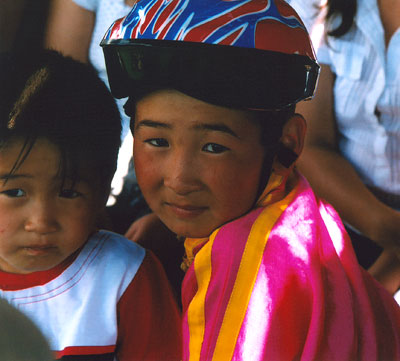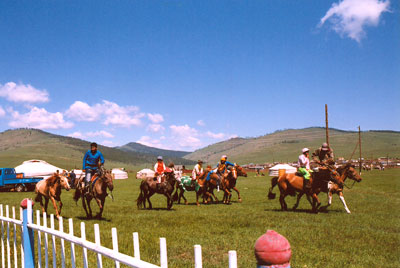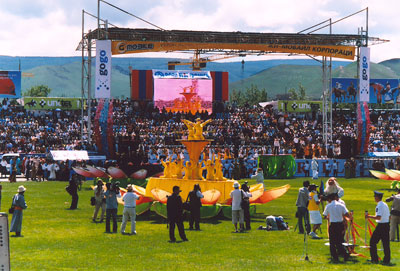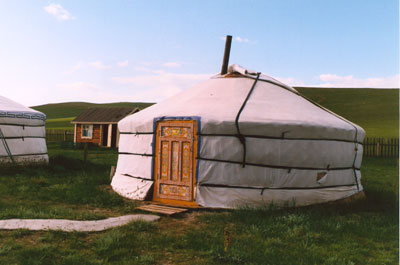Mongolia — Touring the Land of Blue Sky
Sandra Yon, Virginia Beach, VA
Two traveling friends and I had a fantastic 3-week adventure in Outer Mongolia, The Land of Blue Sky, in July ’08. We chose this destination because we wanted to attend the annual Naadam Festival, a sort of Mongolian Olympics. Held every July 11-13, the festival features horse racing, archery and wrestling, competitions that go back many centuries to the military training of ancient warriors.
Starting in UB
We flew into the capital, Ulaanbaatar — or “UB,” as the locals call it — after several days of seeing the sights in Beijing, China. We were met by our wonderful and very knowledgeable guide, Erdenekhuu Enkhjin, or Eegii, as he asked to be called.
While in UB we were able to visit several city museums, notably the Natural History Museum featuring the flora and fauna of the country as well as the remains of the many different dinosaurs found in the Gobi area.
We especially enjoyed the very impressive National Museum of Mongolia, which featured the many different national costumes plus pottery and many exhibits showcasing the history of the lives of Chinggis Khaan (Genghis Khan) and Khubilai Khan.
The exhibits were beautifully done and I was so impressed that I let out a whistle, which resulted in a reaction from those around me. I was quickly informed that one does not whistle inside a building in Mongolia; it’s a sign of bad luck and conjures up bad spirits. I may never whistle in a building again.
Impressive sights
We also spent some time visiting the impressive Gandan Monastery, a Tibetan-style monastery and the most famous one in all of Mongolia. It was constructed in 1838 but was nearly destroyed in the religious purges that began in 1937. Returned to full function in 1990, the monastery is now home to more than 500 monks.
It was quite impressive to enter the Ochidara Temple as many monks were chanting and making loud noises with horns and drums.
Also impressive was the Megjid Janraisig Temple, which houses the giant statue, approximately 80 feet high, of bodhisattva Megjid Janraisig. The present statue, completed in 1996, was built to replace the one constructed in 1911 that was removed by the Communists. The statue is constructed of gilded copper and covered with gold brocade and silk.
This temple also contains hundreds of small statues of Buddha, lining three of the inside walls.
One evening we attended a cultural show featuring the country’s many interesting musical instruments, dances and singers. Most interesting were the throat singers, who created sounds in their throats that I had never heard before and find it impossible to describe.
The show also featured contortionists, all very young girls, who were amazing to watch.
Into the countryside
Leaving UB, we headed into the countryside to attend several local Naadam Festivals. We drove about 150 miles to the east to spend two nights in the Khaan Kherlen Ger Camp, located in the mountainous steppe area of Mongolia.
The camp was located next to a very fast-moving river, the Terelj. Each ger (tent) consisted of a lattice-type round frame covered with a canvas-type material, the inside lined with a silk-like material.
Our ger had three cots, a table and some little benches. There was also a stove in the middle that was lit in the evening to warm the ger and again very early in the morning. Of course, the “facilities” were located quite a distance away.
Here I must mention the roads in Mongolia, or should I say lack of them? Most consisted of ruts that most drivers preferred not to use, so we just went bouncing over the countryside — and I do mean bouncing. I have never been so shook-up in my life. There were no road signs anywhere, so I have to assume the drivers follow the power lines to get to their destinations.
Naadam Festivals
We spent a very lovely day in the little town of Mungungarit attending their local Naadam Festival. There was much pomp and pageantry as they rode their horses around and around the small outdoor stadium. The opening ceremony was impressive, with many locals dressed up in traditional costumes. There was also a flag-raising ceremony and the introduction of the fermented mare’s milk and curd cakes to be awarded to the winners.
The most important event of the festival is the horse racing. We saw the finish of two races, those of the stallions and the geldings. These are not races around a traditional track but 10- to 20- or more mile races from a starting point far away from the finish line, which is located at the site of the festival.
The riders are generally young boys, with a few girls, ages about seven to 12. The winner of the stallion race was seven years old and the second-place winner was 10. We also saw some of the wrestling events.
The next day was spent at another Naadam Festival, in the little town of Erdene. This festival was not quite as big, but the people all showed the same enthusiasm for the events. Again we saw horse racing and wrestling. My suggestion would be to attend at least one local festival.
Monks and Mongolian horses
On our next adventure we traveled southwest of UB to Kharkhorin (Karakorum), the capital of the Mongol Empire in the 13th century. Although the city is no longer there, a very impressive Erdene Zuu Khind, the oldest Buddhist monastery in Mongolia, remains.
An active monastery serving about a thousand monks, it has many temples with lots of statuary. The most impressive part of this monastery is the compound’s fence, consisting of 108 small stupas, or shrines.
We spent three nights in two different ger camps, one located in Hustai National Park. This park is one of three that serve as home to the wild horses that recently have been reintroduced to the country. The wild horses were considered to be extinct in the 1960s due to poaching and loss of habitat, but some had been taken from the country earlier and were being bred in zoos in Europe and Russia.
We were unable to see any of the horses, however, as rains had driven them high into the forest in the mountains.
Back in UB
It was time to experience the opening ceremonies of the big Naadam Festival in Ulaanbaatar. What a show!
There were five colorful lotus plant floats, each filled with contortionists. There were bands, dancers, singers, displays of all the traditional costumes of the country and, of course, horses. The President of Mongolia gave the opening remarks and there was the usual flag raising.
The ceremonies seemed to go on forever, as it was an extremely hot and sunny day. We saw more wrestling and, finally, the archery events. (The smaller festivals did not include archery.)
We did not get to see the horse racing events because they took place about 20 miles outside the city.
Lake Hovsgul and the Gobi
We flew northwest of UB to the little town of Murun to spend two nights at Lake Hovsgul, the second-largest freshwater lake in the world. Here we stayed in another ger camp, Camp Hangard.
The lake was an absolutely vivid turquoise surrounded by a lush green larch forest. On one day we took a horseback ride high up into the mountain forest to look down on this beautiful lake, and on another we were fortunate enough to meet some of the reindeer people who sometimes stop by the lake to camp for a while.
For our last big adventure, we flew to the little town of Dalanzadgad in the Gobi desert, where we visited many interesting and educational sites. The Gobi area is basically scrub, but one area of about a 15-mile stretch has the powdery, Sahara-type sand dunes.
We saw and climbed up the “singing” sand dunes, so named because when the wind blows they are supposed to sound like they are singing. I couldn’t say for sure if this is true or not because there was no wind that day.
We also visited the Flaming Cliffs, the area of the desert where American Roy Chapman Andrews excavated in the 1920s and found the remains of over 100 dinosaurs. He also found dinosaur eggs, the first proof that they were egg layers.
Last look at the Gobi
Often during the trip, we stopped to visit local families in their traditional gers. We were always greeted warmly and offered either the national tea, made from boiled green tea with salt and mare’s milk added, or a cup of mare’s milk.
In the Gobi we visited a camel herder’s family and enjoyed their very warm hospitality. We were offered fermented camel’s milk and camel curd.
We also visited Yolyn Am, an actual glacier in a valley in the middle of the desert. Located in the mouth of a cave, it isn’t as large as it used to be due to global warming.
After a last night in UB, we boarded a Trans-Mongolian Railway train for a 30-hour train ride to Beijing. It was a very interesting ride through the Gobi and on to the border with China. There we had to stop for four hours so the wheels on the train could be changed to fit the differently gauged Chinese track.
We finally arrived in Beijing in the early afternoon, taking with us many fond memories of a very wondrous journey.
Looking back
It is almost impossible to describe the vastness of the country and the blueness of the skies in Mongolia. The scenery was spectacular, with a ger or two here and a herd of goats and sheep or herds of horses there. Then a herder would trot by on his beautiful horse or a golden eagle could be seen sitting by the side of the road. It was just one magnificent sight after another.
If you are planning a trip to Mongolia, I suggest you watch the DVD “The Story of the Weeping Camel.” A Mongolian production with English subtitles, it’s a very heartwarming story that also shows some of Mongolia’s beautiful scenery and family life in a nomad ger. (I ordered it from Amazon.com.)
We booked our tour through Mongol Global Tour Company (4141 Ball Rd. #286, Cypress, CA 90630; 866/225-0577, www.mongolglobaltours.com). The cost of the trip, including several days in Beijing at the beginning and end of the tour, was $4,457 per person. International airfare round trip from Norfolk, Virginia, was $1,790. For a 23-day trip, I felt this was a bargain.
The tour company really worked with us, booking several extras that we wanted to experience, such as the local festivals.





